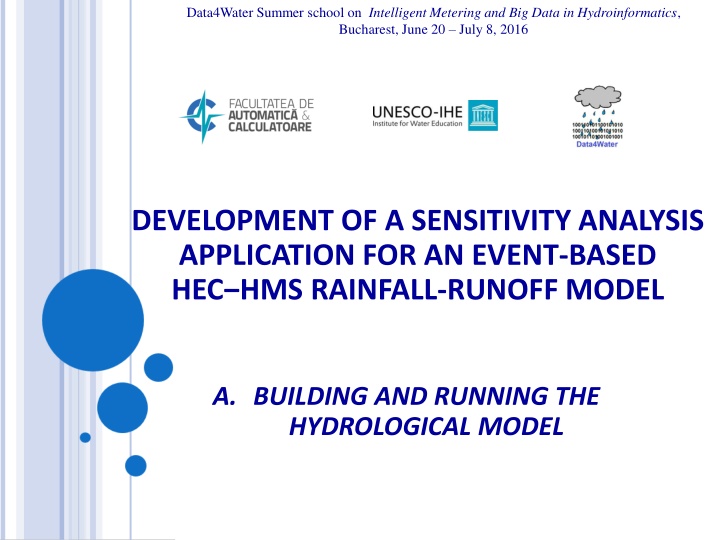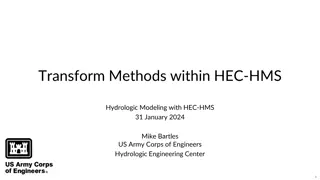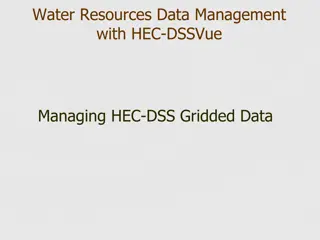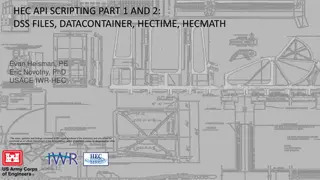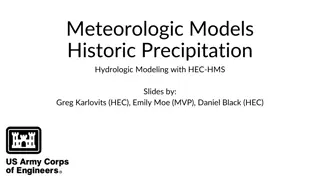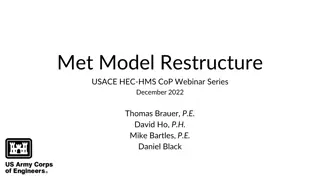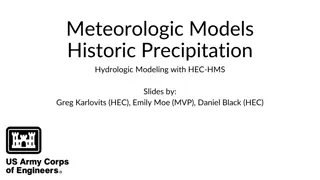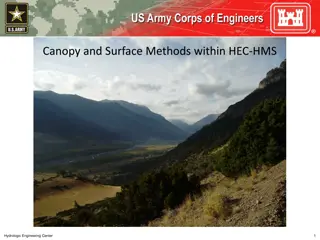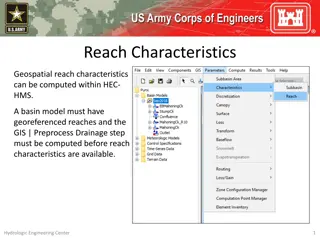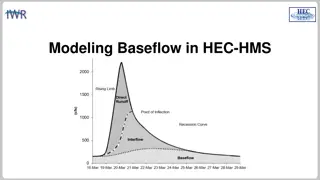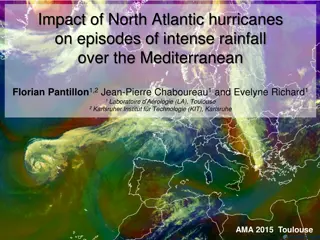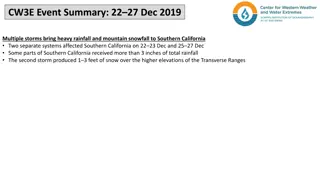Development of Sensitivity Analysis Application for HEC HMS Rainfall-Runoff Model
This content discusses the development of a sensitivity analysis application for an event-based HEC HMS rainfall-runoff model. It covers hydrological modeling, simulation options, Siron basin modeling, meteorological modeling, control specifications, and more.
Download Presentation

Please find below an Image/Link to download the presentation.
The content on the website is provided AS IS for your information and personal use only. It may not be sold, licensed, or shared on other websites without obtaining consent from the author.If you encounter any issues during the download, it is possible that the publisher has removed the file from their server.
You are allowed to download the files provided on this website for personal or commercial use, subject to the condition that they are used lawfully. All files are the property of their respective owners.
The content on the website is provided AS IS for your information and personal use only. It may not be sold, licensed, or shared on other websites without obtaining consent from the author.
E N D
Presentation Transcript
Data4Water Summer school on Intelligent Metering and Big Data in Hydroinformatics, Bucharest, June 20 July 8, 2016 DEVELOPMENT OF A SENSITIVITY ANALYSIS APPLICATION FOR AN EVENT-BASED HEC HMS RAINFALL-RUNOFF MODEL A. BUILDING AND RUNNING THE HYDROLOGICAL MODEL
Data4Water Summer school on Intelligent Metering and Big Data in Hydroinformatics, Bucharest, June 20 July 8, 2016 HYDROLOGICAL MODELING Hydrological modeling simulate the precipitation runoff of watershed MODEL COMPONENTS Simulation options: Event modeling (Initial constant, SCS Curve Number, Exponential, Green & Ampt, Smith Parlange) Continuous modeling (one-layer deficit constant method, three- layer soil moisture accounting method) SIRON BASIN MODEL SIRON METEO MODEL Objective: Building a model to simulate a storm event on Siron river basin SIRON CONTROL Model requirements: State variables Parameters Boundary conditions Initial conditions SIRON TIME SERIES Siron basin
Data4Water Summer school on Intelligent Metering and Big Data in Hydroinformatics, Bucharest, June 20 July 8, 2016 HYDROLOGICAL MODELLING Basin Model Uses time series data and specific sets of parameters to represent the hydrologic system Contains multiple methods to simulate each hydrological processes: runoff volume = loss (infiltration-saturation-runoff) direct runoff = transform (effective rainfall-runoff) baseflow MODEL COMPONENTS SIRON BASIN MODEL Meteorological Model Defines the gage data input that is transformed during the simulation into effective precipitation, cumulated precipitation per time step, precipitation excess etc. Can use various meteorological parameters (air temperatures, air humidity etc.) to simulate snowmelt and evapotranspiration SIRON METEO MODEL SIRON CONTROL SIRON Control specifications Sets the time interval of the simulation Includes the time step for the computation TIME SERIES Time series data Manually or read from file time series data; gridded data; paired data entered manually or automatically (HEC-DSS).
Data4Water Summer school on Intelligent Metering and Big Data in Hydroinformatics, Bucharest, June 20 July 8, 2016 HYDROLOGICAL MODELLING Loss SCS Curve Number Method - implements curve number methodology for incremental losses (NRCS,2007) MODEL COMPONENTS SIRON Parameters needed: BASIN MODEL Initial Abstraction (m3/s): amount of precipitation that must infiltrate before surface excess results SIRON METEO MODEL Curve number: - expresses the runoff potential and it is dependent on soil permeability, land coverage, basin area - the range for CN values is 0 100 without ever reaching to the extreme values CN = 0 the entire amount of precipitation infiltrates = low runoff potential CN = 100 impervious soils = high runoff potential SIRON CONTROL SIRON TIME SERIES Impervious (%): the share of the basin area that is impervious - all precipitation becomes direct runoff
Data4Water Summer school on Intelligent Metering and Big Data in Hydroinformatics, Bucharest, June 20 July 8, 2016 HYDROLOGICAL MODELLING Transform Snyder Unit Hydrograph calculates the unit hydrograph through Snyder s method MODEL COMPONENTS Parameters needed: SIRON BASIN MODEL Standard Lag (hr): time between the centroid of excess rainfall and the centroid of the resulting hydrograph depends on: basin area, slope, river network length, curve number SIRON METEO MODEL SIRON 0,7 ? 3,28 1030.8 1000 ?? 9 CONTROL ????= , where: 1900 ?0,5 SIRON ????= ??? ????, ?? = ????? ??????, ? = ?????, ? = ????? ??????? ????? TIME SERIES GIS basin area, slope, river length network Peaking Coefficient: steepness of the hydrograph that results from a unit of precipitation
Data4Water Summer school on Intelligent Metering and Big Data in Hydroinformatics, Bucharest, June 20 July 8, 2016 HYDROLOGICAL MODELLING MODEL Baseflow Exponential recession COMPONENTS Parameters needed: SIRON BASIN MODEL Initial Discharge (m3/s): the initial value from which the baseflow for each time step is calculated SIRON METEO MODEL Recession Constant: defined as the ratio of present baseflow value at previous time step baseflow SIRON CONTROL Threshold Type: discharge value at which all runoff is considered baseflow; if Ratio to Peak is chosen, the threshold is dependent on the peak value (not a fixed discharge value) SIRON TIME SERIES
Data4Water Summer school on Intelligent Metering and Big Data in Hydroinformatics, Bucharest, June 20 July 8, 2016 HYDROLOGICAL MODELLING Meteorological model: MODEL COMPONENTS Gage Weights specify the weights to defined precipitation gages (in our study case just one precipitation gage was used) SIRON BASIN MODEL Control data: SIRON METEO MODEL START DATE and TIME: dd.mm.yyyy hh:mm END DATE and TIME: dd.mm.yyyy hh:mm COMPUTATION TIME STEP: 1 minute 1 Day (1 hour in our case study) SIRON CONTROL Time series data: SIRON TIME SERIES Precipitation (mm) Discharge (m3/s)
